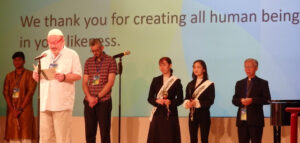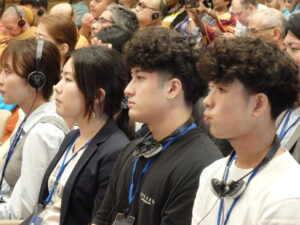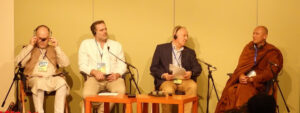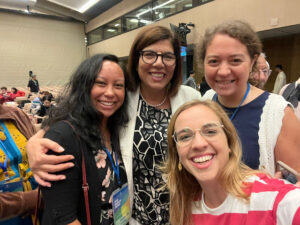
For five days, approximately five hundred people from around the globe participated in this event. Among them were rabbis and rabbinic students, imams, Catholic priests, a reformed minister, Theravada and Mahayana Buddhist monks, as well as Catholic monks. Laypeople from various faiths, including Jews, Muslims, Christians, Hindus, Buddhists, Sikhs, and Baha’is, were present. Young and old, it was a truly kaleidoscopic gathering long planned and finally realized to bear witness, as the conference title proclaimed: One Human Family. Some skeptics, who were not present, deemed the title ‘banal’ and questioned the significance of the initiative’s promoters.
Yet, those who experienced these days agree that they were transformative, allowing for the experience of a shared and genuine fraternity. Genuine because it wasn’t always easy. One morning, a Jewish friend confided her discomfort over something a Muslim had said the previous day. She noted that her reaction would have been quite different ten years ago. Time had honed her ability to engage in dialogue at all costs. She understood that she couldn’t leave the door open to feelings that would make her react, especially in these months of wars, massacres, kidnappings, and bloodshed, leading to strong polarization.
I spent the first two days of the conference with a group of fifty facilitators (Jews, Christians, Muslims, Hindus, Buddhists, and Baha’is) dedicated to deepening the spirituality that enables dialogic practice. The results of years and decades of practice, far from taken for granted, were evident during these days. One day, after lunch, I saw an Orthodox Jewish woman eating with Muslims. One afternoon, two monks conversed with a group of Turkish Muslim women living in Germany.
This time, there were no closed groups bound by their own culture, language, or religion. Only the Buddhist monks adhered strictly to their meal times, consuming meals before noon as their sangha (monastic community) practices. By the third day, the group had grown to three hundred people from various ethnicities, cultures, and religions, and began addressing today’s burning issues. Experts from different faiths discussed religion and peace, with particular attention to international relations. They also tackled religion and economics, and religion and artificial intelligence, culminating on Sunday with a large round table discussion on ‘religions and peace with creation’. In this final session, a diverse panel consisting of an American Christian, a Japanese Buddhist, an Algerian-born rabbi now living in Tel Aviv, a Hindu from South India, and an Indonesian Muslim spoke before a packed hall in complete silence. As the rabbi remarked, they captured sparks of wisdom and sanctity.
The sessions were demanding, some even heavy, while others were highly interactive. The participants, all experts with diverse backgrounds and well-defined religious roots, contributed to a cultural dimension of this dialogic experience, perhaps unprecedented in these contexts. Yet, all this never overshadowed the life and everyday experiences that followed these cultural reflections, showing that many are working diligently in various parts of the world to implement and continue these discussions. The impression was of a unique experience, the result of years, often decades, of commitment, as my Jewish friend noted. These are people who have transformed over the years, remaining anchored to their culture and religion, which they have deepened through their commitment to dialogue.
There were also curious participants who came to see what a dialogue experience is truly like. Some committed Christians with a highly self-referential perspective struck me. Among them—hopefully—some may have realized that things are not as they had imagined. But conviction is another matter, and often a conference or coexistence of this kind is not enough. On the other hand, I saw enthusiastic young people—Buddhists, Jews, Muslims, and also Catholics, though in smaller numbers—who decided to dedicate themselves to this dialogic adventure. Speaking with a 22-year-old from northern Italy, I realized how decisive relationships with peers of the same generation were for future choices.
I was accompanied by some students from our Sophia University Institute. They felt transformed by this experience, and I cannot blame them. The same happened to me. I felt transformed, in heart and mind, thanks to an increasingly prophetic adventure that has characterized the last thirty years of my life, for which I w ill never be grateful enough to those who proposed and encouraged me to follow it, even in moments like these, when it might seem madness and, perhaps, mere ‘banality’. But what matters in dialogue—especially interreligious dialogue—is being there. Absence is almost a fault. (from Let’s Dialogue blog)
ill never be grateful enough to those who proposed and encouraged me to follow it, even in moments like these, when it might seem madness and, perhaps, mere ‘banality’. But what matters in dialogue—especially interreligious dialogue—is being there. Absence is almost a fault. (from Let’s Dialogue blog)



